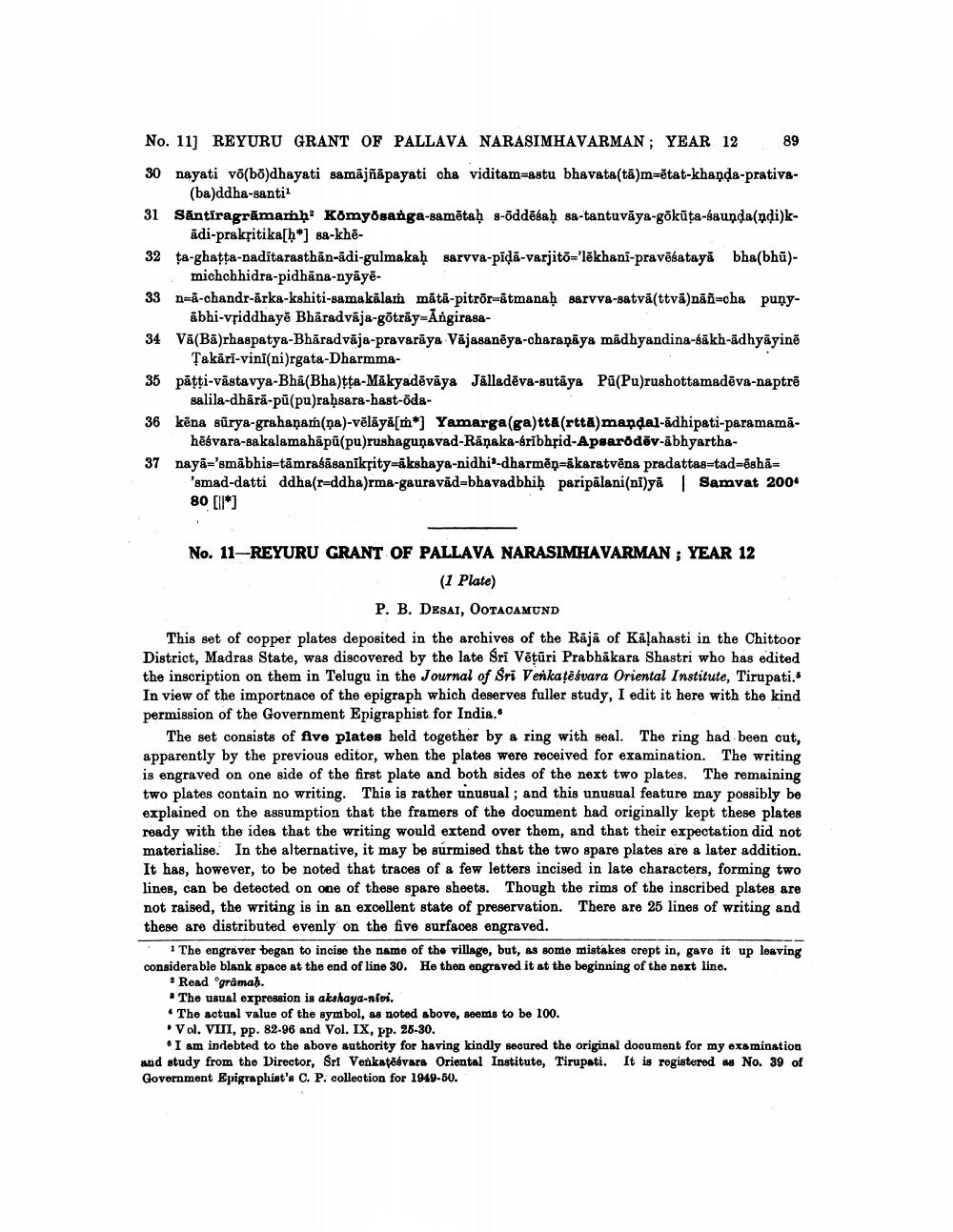________________
No. 111 REYURU GRANT OF PALLAVA NARASIMHAVARMAN : YEAR 12
89
30 nayati võ(bo)dhayati samājñāpayati cha viditam=astu bhavata(tā)m=etat-khanda-prativa
(ba)ddha-santi 31 Santiragrämarḥ Kömyösanga-samētaḥ -āddēśaḥ sa-tantuvāya-göküta-launda(ndi)k
ādi-prakritika[h*] sa-khē32 ţa-ghatta-nadītarasthān-ādi-gulmakaḥ sarvva-pīdā-varjitõ='lēkhanī-pravēšatayā bha(bhū)
michchhidra-pidhāna-nyāye33 n=ā-chandr-ārka-kshiti-samakālam mātā-pitror=ātmanaḥ sarvva-satvā(ttvā)nāñ=cha puny
abhi-vriddhayē Bhāradvāja-gotrāy=Angirasa34 Vā(Bā)rhaspatya-Bhāradvāja-pravarāya VājasanĒya-charaṇāya mādhyandina-bākh-ādhyāyinē
Takāri-vini(ni)rgata-Dharmma35 pāțti-vāstavya-Bhā(Bha)tta-Mākyadēvāya Jālladēva-Butāya Pū(Pu)rushottamadēva-naptrē
salila-dhārā-pū(pu)raḥsara-hast-oda36 kēna sūrya-grahaņaņ(na)-vēlāyā[**] Yamarga(ga)tta(rtta)mandal-adhipati-paramamā
hēsvara-sakalamahāpū(pu)rushagunavad-Rāņaka-érībhfid-Apsarodēv-ābhyartha37 nayā='smābhis=tāmrasāsanikțity=ākshaya-nidhi-dharmēņ=ākaratvēna pradattas=tad=éshā=
'smad-datti ddha(r=ddha)rma-gauravād=bhavadbhiḥ paripālani(nī)yă | Samvat 2004 80 [II*]
No. 11-REYURU GRANT OF PALLAVA NARASIMHAVARMAN ; YEAR 12
(1 Plate)
P. B. DESAI, OOTACAMUND This set of copper plates deposited in the archives of the Rājā of Kāļahasti in the Chittoor District, Madras State, was discovered by the late Sri Vētūri Prabhākara Shastri who has edited the inscription on them in Telugu in the Journal of Sri Venkatëśvara Oriental Institute, Tirupati. In view of the importnace of the epigraph which deserves fuller study, I edit it here with the kind permission of the Government Epigraphist for India.
The set consists of five plates held together by a ring with seal. The ring had been cut, apparently by the previous editor, when the plates were received for examination. The writing is engraved on one side of the first plate and both sides of the next two plates. The remaining two plates contain no writing. This is rather unusual ; and this unusual feature may possibly be explained on the assumption that the framers of the document had originally kept these plates ready with the idea that the writing would extend over them, and that their expectation did not materialise. In the alternative, it may be surmised that the two spare plates are a later addition. It has, however, to be noted that traces of a few letters incised in late characters, forming two lines, can be detected on one of these spare sheets. Though the rims of the inscribed plates are not raised, the writing is in an excellent state of preservation. There are 25 lines of writing and these are distributed evenly on the five surfaces engraved.
1 The engraver began to incise the name of the village, but, as some mistakes crept in, gave it up leaving considerable blank space at the end of line 30. He then engraved it at the beginning of the next line.
2 Read grämah. * The usual expression is akshaya-niui. • The actual value of the symbol, as noted above, seems to be 100. "Vol. VIII, pp. 82-96 and Vol. IX, pp. 26-30.
. I am indebted to the above authority for having kindly secured the original document for my examination and study from the Director, Sri Venkatēsvars Oriental Institute, Tirupati. It is registered No. 39 of Government Epigraphist's C. P. collection for 1949-50.




